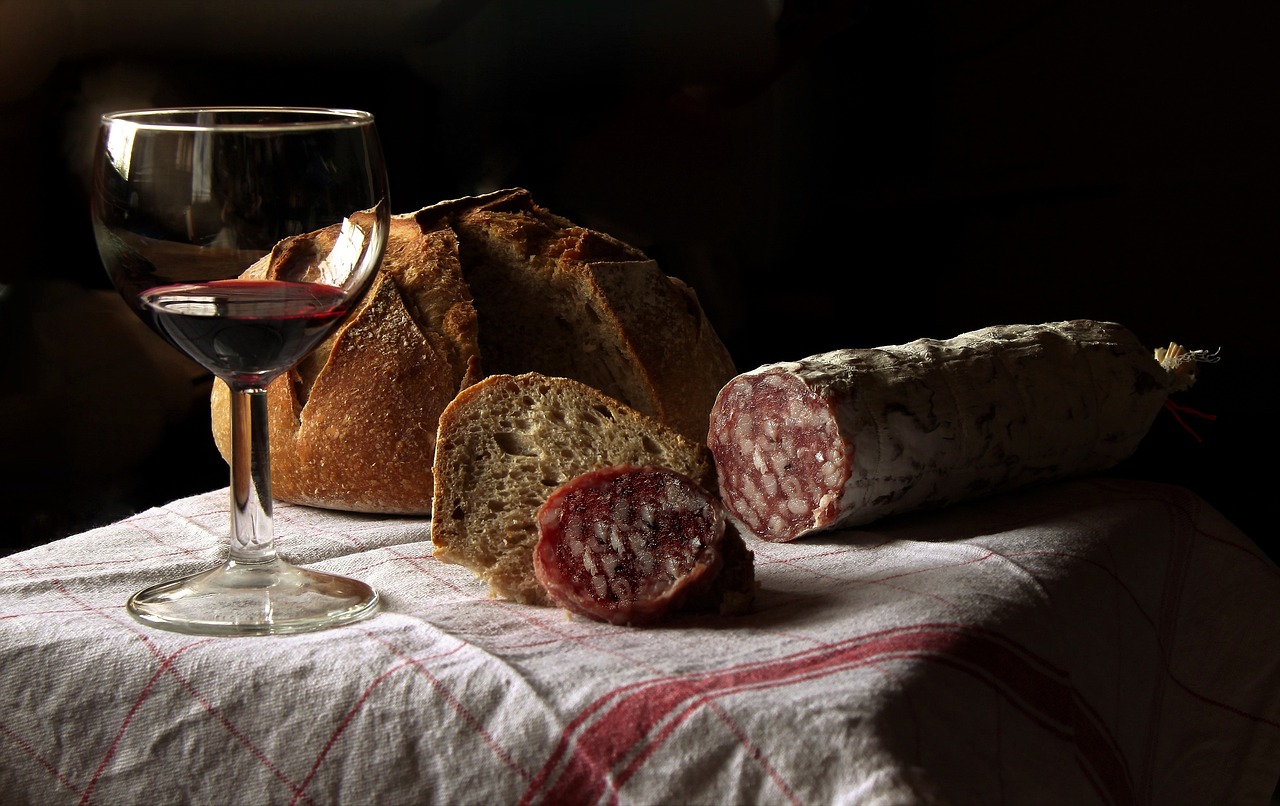Embark on an enchanting global expedition as we uncover the captivating story of wine. Tastepan.com is your guide on this journey, whisking you away to the fruitful vineyards and rolling hills where the magic happens. Delve into the intricacies of terroir, where the soil, climate, and geography converge to shape the unique character of each wine. Learn about the vast array of varietals, from bold reds to delicate whites, and discover how different grapes produce distinct flavors and aromas. Join us as we wander through the vineyards and dive into the fascinating world of wine, a celebration of traditions, cultures, and flavors that transcend borders. Let your taste buds embark on a global exploration as we uncork the secrets behind this timeless elixir.

Terroir: The Essence of Wine
Terroir is a term that wine enthusiasts often encounter, but what does it really mean? In essence, terroir refers to the unique combination of factors that influence the taste and character of a wine. These factors include the soil composition, climate, topography, and even the winemaking traditions of a specific region. Understanding the concept of terroir is essential for appreciating and differentiating between various wine styles.
The importance of terroir in the world of wine cannot be overstated. It is the very essence of what makes each wine individual and distinct. The soil composition, for example, affects the availability of nutrients to the vines, which in turn affects the flavor and quality of the grapes. Similarly, the climate plays a crucial role by determining the length of the growing season and the grapes’ exposure to sunlight. All these elements work together to create a unique flavor profile that cannot be replicated elsewhere.
Factors Influencing Terroir
There are several key factors that influence terroir and contribute to the exceptional characteristics of a wine. Firstly, soil composition is of utmost importance. Different types of soil, such as limestone, clay, or volcanic ash, can impart distinct flavors and textures to the grapes. The climate, including temperature, rainfall, and sun exposure, also greatly impacts the grapes’ ripening process. Furthermore, the topography of a region, such as its altitude and slope, can influence factors like drainage and microclimates, thus affecting the grapes’ development. Lastly, the winemaking traditions and techniques employed in a specific area contribute to the unique expression of terroir in its wines.
Examples of Famous Terroirs
Throughout the world, there are numerous regions celebrated for their exceptional terroirs and the wines they produce. Burgundy in France, for instance, is renowned for its intricate terroir, with different vineyards producing wines with distinct characteristics. The soils of Chablis, known as Kimmeridgian clay, give its wines a vibrant minerality. In contrast, the clay limestone soils of the Côte de Nuits and Côte de Beaune produce bold and complex Pinot Noir and Chardonnay.
Moving across the globe, the Napa Valley in California is another prime example of an iconic terroir. The combination of its Mediterranean climate, gravelly soils, and the influence of the Pacific Ocean creates ideal conditions for growing Cabernet Sauvignon. The resulting wines are known for their opulence and rich flavors.
Varietals: The Different Faces of Wine
Varietals are another essential aspect of wine that contributes to its diversity and allure. They refer to the specific type of grape used in winemaking. Each varietal possesses unique flavors, aromas, and structural characteristics that distinguish it from others. Understanding varietals is crucial for both wine enthusiasts and professionals as it allows for better appreciation and evaluation of the wine’s qualities.
Definition of Varietals
In simplest terms, varietals are the different types of grape varieties used to make wine. While there are thousands of grape varieties grown worldwide, certain varietals have gained significant recognition and popularity. Wine labels often prominently display the varietal name, such as Cabernet Sauvignon, Chardonnay, or Merlot, indicating the grape variety that comprises the majority of the wine.
Commonly Grown Varietals Around the World
The world of wine is rich with a myriad of varietals, each with its own unique characteristics. In Europe, classic varietals like Cabernet Sauvignon, Chardonnay, and Pinot Noir have long been celebrated. In Spain, Tempranillo is a popular red varietal, known for its versatility and ability to produce both medium-bodied and full-bodied wines. Meanwhile, Riesling, a versatile white varietal capable of producing both dry and sweet wines, is highly regarded in Germany.
Unique and Uncommon Varietals
While some varietals enjoy widespread recognition, there are countless others that are lesser-known and often overlooked. These unique varietals offer an opportunity to explore new and intriguing flavors. For instance, the Assyrtiko grape from Santorini, Greece, produces vibrant, high-acid white wines with a distinct mineral character. Aglianico, an Italian red varietal, offers robust and tannic wines with rich black fruit flavors. Exploring these uncommon varietals can be a thrilling journey for wine enthusiasts looking to expand their horizons.
Vineyards: The Heart of Wine Production
A vineyard is more than just a plot of land with rows of grapevines; it is the very heart of wine production. Vineyards play a crucial role in shaping the final product, as they are responsible for nurturing the grapes and providing the raw materials for winemaking. Understanding the significance of vineyards is key to appreciating the intricacies of wine production.
Role of Vineyards in Wine Production
Vineyards are where the magic begins. They are carefully designed and cultivated to provide the ideal conditions for grape growing. From soil management to grapevine training, vineyard owners and winemakers meticulously care for the vines throughout the year. The health and quality of the grapes depend on factors such as proper irrigation, disease prevention, and canopy management. Without well-maintained vineyards, the production of exceptional wines would not be possible.
Famous Vineyards Around the World
Certain vineyards have gained worldwide recognition for consistently producing exceptional wines. The vineyards of Bordeaux, for example, are held in high esteem for their renowned red blends. Château Haut-Brion and Château Margaux are esteemed vineyards that have stood the test of time, producing wines of exceptional quality and age-worthiness.
In the New World, California’s vineyards, such as Opus One in Napa Valley or Ridge Vineyards in Sonoma, have carved their places in the wine industry’s history. These vineyards showcase the potential of their terroir and produce wines that captivate enthusiasts across the globe.
Sustainable and Organic Vineyard Practices
With increased awareness of environmental sustainability, many vineyards have embraced sustainable and organic practices. Sustainable vineyard practices focus on minimizing environmental impact, conserving resources, and ensuring long-term viability. This includes practices such as water conservation, using natural pest control methods, and reducing greenhouse gas emissions.
Organic vineyard practices take sustainability a step further by eliminating the use of synthetic pesticides, herbicides, and fertilizers. Instead, natural alternatives are used to maintain grape health and control pests. These practices not only benefit the environment but also contribute to the production of wines that are free from chemical residues, ensuring a more natural and healthy product.

Old World vs. New World: Contrasting Wine Styles
Old World and New World wines offer distinct styles and characteristics that stem from their respective regions and winemaking traditions. Understanding the differences between these styles is essential for wine enthusiasts to appreciate the nuances and explore the wide range of flavors available.
Characteristics of Old World Wines
Old World wines are typically associated with Europe, where winemaking has been practiced for centuries. These wines tend to be more restrained, emphasizing earthy and mineral qualities. Old World winemaking traditions often prioritize preserving the grape’s natural flavors and showcasing the terroir rather than emphasizing fruit-forward characteristics. This results in wines that are more subtle, with balanced acidity and a sense of place.
Characteristics of New World Wines
New World wines, on the other hand, originate from regions outside of Europe, such as the United States, Australia, or South America. These wines often exhibit bolder, fruit-driven flavors. New World winemakers embrace innovation and experimentation, aiming to produce wines that are approachable, full-bodied, and expressive. The emphasis is on ripe fruit flavors, often complemented by oak aging and higher alcohol levels.
Notable Wine Regions in Each Style
When exploring Old World wines, regions such as Bordeaux in France, known for its structured and age-worthy red blends, and Burgundy, revered for its elegant Pinot Noir and Chardonnay, are must-visit destinations. In contrast, New World wine regions like Napa Valley in California, famous for its opulent Cabernet Sauvignon, or Marlborough in New Zealand, renowned for its vibrant, fruit-driven Sauvignon Blanc, offer a different experience with their distinct styles.
The Influence of Climate on Wine
Climate plays a fundamental role in grape ripening and wine production. The variations in temperature, rainfall, and sunlight result in different wine styles, making climate a defining factor in the world of wine. Understanding the influence of climate is crucial for both winemakers and enthusiasts to appreciate the diversity and range of wines available.
Cool Climate vs. Warm Climate Wines
The climate in which grapes are grown greatly affects their development and the resulting wine’s characteristics. Cool climate wines, typically found in regions closer to the poles or at higher altitudes, tend to be more acidic and have a lighter body. These wines often exhibit more delicate flavors, such as citrus, green apple, and herbal notes. In contrast, warm climate wines, which thrive in regions with long, hot summers, produce riper and more full-bodied wines. These wines often showcase flavors of ripe fruits, such as blackberries, cherries, and plums.
Effects of Temperature and Sunlight on Grape Ripening
Temperature and sunlight are crucial factors that impact grape ripening and ultimately determine the flavors and quality of the resulting wine. During the growing season, temperature fluctuations can affect the grapes’ sugar development, acidity levels, and phenolic compounds. Sunlight exposure, specifically the intensity and duration, influences the grapes’ ability to ripen fully and develop complex flavors. Understanding these effects allows winemakers to make informed decisions about harvest timing and vineyard management practices.
Climate Change and its Impact on the Wine Industry
Climate change poses significant challenges and opportunities for the wine industry. Rising temperatures and unpredictable weather patterns can lead to shifts in vineyard suitability, altering the regions where specific varietals can thrive. Moreover, climate change can impact the timing of grape ripening, potentially affecting the wines’ balance and flavor profiles. Winemakers around the world are adapting to these changes by exploring alternative grape varieties, adjusting viticultural practices, and implementing sustainable measures in their vineyards to combat the effects of climate change.
Wine and Culture: Traditional Practices and Rituals
Wine has a rich and storied history intertwined with various cultures around the world. Its significance as a beverage extends far beyond its taste and characteristics. Wine has played a role in cultural, social, and religious practices throughout history, making it a symbol of tradition and celebration.
Historical Importance of Wine in Different Cultures
Different cultures have embraced wine throughout the centuries, recognizing its importance as a social lubricant and a symbol of status. In ancient Greece, for example, wine was associated with the god Dionysus and played a vital role in religious rituals and theater. In France, wine has been an integral part of the country’s cultural identity, with winemaking traditions passed down through generations.
Wine in Religious Ceremonies
Wine holds deep spiritual significance in many religious ceremonies and rituals. In Christianity, wine is an integral part of the Eucharist, symbolizing the blood of Christ. In Judaism, wine plays a significant role during Passover, with specific blessings and rituals associated with its consumption. These religious practices highlight wine’s cultural and spiritual connection, bringing together communities through shared traditions.

Wine as a Symbol of Celebration
Wine has long been associated with celebrations and joyous occasions. From wedding toasts to New Year’s Eve, wine is often the beverage of choice for commemorating special moments. Its presence signifies festivity, conviviality, and the sharing of experiences. Wine’s ability to evoke celebration and create lasting memories has solidified its place in cultures around the world.
Emerging Wine Regions: Exploring New Frontiers
While certain wine regions have a long-established reputation for producing exceptional wines, there are also emerging regions that are gaining recognition for their quality and unique expressions of terroir. Exploring these new frontiers allows wine enthusiasts to discover exciting and diverse expressions of the winemaking craft.
Up-and-coming Wine Regions
Several emerging wine regions are making waves in the industry, offering wines that captivate connoisseurs with their distinct characteristics. Oregon’s Willamette Valley, for example, has gained a reputation for producing outstanding Pinot Noir, thanks to its cool climate and volcanic soils. In the southern hemisphere, regions like Marlborough in New Zealand and the Mendoza region in Argentina are continuously impressing with their Sauvignon Blanc and Malbec, respectively.
Challenges and Opportunities in Emerging Wine Regions
Emerging wine regions face numerous challenges and opportunities as they strive to establish themselves on the global wine stage. The lack of historical recognition can make it difficult to compete with established regions, but it also provides the freedom to experiment and break away from traditional winemaking practices. These regions have the opportunity to showcase their unique terroir and make a name for themselves by producing distinctive and high-quality wines.
Success Stories of Recently Established Wine Regions
There are success stories aplenty when it comes to recently established wine regions, proving that with passion, dedication, and a commitment to quality, even new players can make a mark. For example, Central Otago in New Zealand, known for its exceptional Pinot Noir, has quickly gained recognition as one of the country’s premier wine regions. Similarly, the Okanagan Valley in British Columbia, Canada, has emerged as a thriving wine region, producing a diverse range of varietals, including Riesling, Pinot Noir, and Syrah.
Wine Tourism: A Journey for the Senses
Wine tourism is a growing trend that allows enthusiasts to immerse themselves in the world of wine and experience firsthand the regions and vineyards that produce their favorite wines. It provides a unique opportunity to engage with the winemaking process, taste local wines, and learn about the rich history and culture surrounding wine production.
The Concept of Wine Tourism
Wine tourism combines the pleasure of travel with the passion for wine. It offers visitors the chance to explore vineyards, wineries, and tasting rooms, making it a multisensory experience. Wine enthusiasts can learn about the winemaking process, from grape harvesting to bottling. They can also participate in tasting sessions, allowing them to better appreciate the wines’ nuances and the influence of terroir on their taste.
Top Wine Destinations for Tourists
Several regions around the world have emerged as top wine destinations, attracting wine lovers from near and far. Napa Valley in California is a perennial favorite, renowned for its stunning vineyard landscapes and world-class wineries. The region offers a range of experiences, from intimate tastings at boutique wineries to lavish vineyard tours. Tuscany in Italy is another popular destination, known for its rolling hills, vine-covered landscapes, and iconic wineries producing renowned Chianti and Brunello di Montalcino.
Experiences and Activities Offered by Wine Tourism
Wine tourism is not just about savoring the flavors of wine; it is a multifaceted experience that engages all the senses. Visitors can partake in vineyard tours, strolling through picturesque rows of vines and learning about viticulture. Many wineries offer tastings, allowing guests to sample a selection of wines and learn about their unique qualities. Food and wine pairing experiences are also popular, showcasing the harmonious relationship between wine and cuisine. Wine tourism provides an opportunity to indulge in the luscious flavors of wine while immersing oneself in the beauty and culture of wine regions.
Winemaking Techniques: Tradition Meets Innovation
Winemaking is an intricate craft that blends ancient traditions with modern innovation. The techniques employed in the winemaking process greatly impact the style, quality, and overall character of the wines produced. Understanding these techniques allows for a deeper appreciation of the craftsmanship involved in creating each bottle of wine.
History of Winemaking Techniques
Winemaking can be traced back thousands of years, with techniques evolving and adapting over time. Ancient civilizations, such as the Egyptians and Greeks, laid the foundation for winemaking practices. Techniques like grape pressing, fermentation, and aging in clay vessels were established during this time. As winemaking spread throughout Europe and the rest of the world, various regions developed their own unique techniques based on local resources and preferences.
Traditional Methods vs. Modern Techniques
Traditional winemaking methods often prioritize minimal intervention to allow the grapes and terroir to speak for themselves. These methods may include hand-harvesting, foot trodding, and aging the wine in oak barrels. In contrast, modern winemaking techniques incorporate technological advancements for precision and consistency. This can include the use of temperature-controlled fermentation, mechanical harvesting, and micro-oxygenation. Both traditional and modern techniques have their merits, and winemakers often blend the two to achieve their desired style and expression of terroir.
Emerging Trends in Winemaking
The world of winemaking is constantly evolving, with new trends and innovations shaping the industry. One significant trend is the focus on natural winemaking, where minimal intervention is used, and sulfur additions are limited. This approach aims to produce wines that showcase the purest expression of the grapes and terroir. Additionally, the use of alternative winemaking vessels, such as concrete or amphorae, is gaining popularity, contributing unique textures and flavors to the wines. As technology continues to advance, precision viticulture and data analysis tools are also becoming key tools for winemakers, allowing them to fine-tune their practices and maximize quality.
The Future of Wine: Trends and Predictions
As consumer preferences evolve, technological advancements continue, and sustainability takes center stage, the future of the wine industry is undoubtedly evolving. Recognizing these trends and predictions not only helps industry professionals stay ahead of the curve but also allows wine enthusiasts to anticipate and embrace the changes that lie ahead.
Changing Consumer Preferences
Consumer preferences are shifting towards wines that reflect their values, whether it be sustainability, organic production, or unique and obscure varietals. There is a growing interest in wines that tell a story, with consumers seeking out winemakers who are transparent about their practices and philosophies. Moreover, the trend of wine as a lifestyle, where wine is enjoyed as part of a holistic experience, is gaining momentum. This includes wine and food pairings, wellness-focused wine events, and sustainable wine tourism.
Technological Advancements in the Wine Industry
Technology continues to play a significant role in shaping the future of the wine industry. From vineyard management to winemaking techniques, new advancements offer innovative solutions and possibilities. Precision viticulture, for example, allows winemakers to utilize data-driven tools for efficient vineyard management, optimizing grape quality and reducing environmental impact. Additionally, new winemaking equipment, such as optical sorters and automated bottling systems, enhance efficiency and quality control.
Sustainable Practices for the Future
Sustainability has become a central focus in the wine industry, as both producers and consumers recognize the importance of environmental stewardship. Vineyard owners and winemakers are increasingly adopting sustainable practices, such as organic or biodynamic farming methods, water conservation, and renewable energy sources. Many wineries are also actively involved in community initiatives, supporting local economies and promoting social responsibility. The future of wine lies in a more sustainable, responsible, and environmentally conscious industry.
In conclusion, the world of wine is a captivating tapestry of flavors, cultures, and traditions. Terroir, varietals, vineyards, and winemaking techniques all contribute to the unique and diverse wines that grace our glasses. Understanding and appreciating these facets allows us to embark on a journey of exploration, experiencing the nuances of taste, and connecting with the rich heritage of wine. As the wine industry continues to evolve, embracing sustainability, innovation, and changing consumer preferences, the future promises new discoveries and exciting possibilities for both producers and consumers alike.

